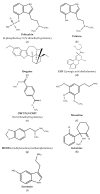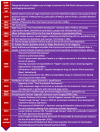The Therapeutic Potential of Psilocybin
- PMID: 34063505
- PMCID: PMC8156539
- DOI: 10.3390/molecules26102948
The Therapeutic Potential of Psilocybin
Abstract
The psychedelic effects of some plants and fungi have been known and deliberately exploited by humans for thousands of years. Fungi, particularly mushrooms, are the principal source of naturally occurring psychedelics. The mushroom extract, psilocybin has historically been used as a psychedelic agent for religious and spiritual ceremonies, as well as a therapeutic option for neuropsychiatric conditions. Psychedelic use was largely associated with the "hippie" counterculture movement, which, in turn, resulted in a growing, and still lingering, negative stigmatization for psychedelics. As a result, in 1970, the U.S. government rescheduled psychedelics as Schedule 1 drugs, ultimately ending scientific research on psychedelics. This prohibition on psychedelic drug research significantly delayed advances in medical knowledge on the therapeutic uses of agents such as psilocybin. A 2004 pilot study from the University of California, Los Angeles, exploring the potential of psilocybin treatment in patients with advanced-stage cancer managed to reignite interest and significantly renewed efforts in psilocybin research, heralding a new age in exploration for psychedelic therapy. Since then, significant advances have been made in characterizing the chemical properties of psilocybin as well as its therapeutic uses. This review will explore the potential of psilocybin in the treatment of neuropsychiatry-related conditions, examining recent advances as well as current research. This is not a systematic review.
Keywords: addiction; anxiety; cancer; depression; magic mushrooms; neuropharmaceuticals; neurotherapeutics; psilocybin; psychedelic; psychopharmacology.
Conflict of interest statement
The authors declare no conflict of interest.
Figures







References
-
- Buddy T. The Types of Dissociative Drugs. [(accessed on 23 March 2021)];2020 Available online: https://www.verywellmind.com/what-are-dissociative-drugs-63387.
-
- NIDA What Are the Effects of Common Dissociative Drugs on the Brain and Body? [(accessed on 23 March 2021)];2020 Available online: https://www.drugabuse.gov/publications/research-reports/hallucinogens-di....
Publication types
MeSH terms
Substances
LinkOut - more resources
Full Text Sources
Other Literature Sources
Medical
Research Materials

